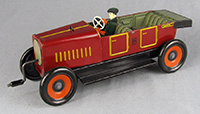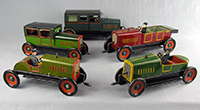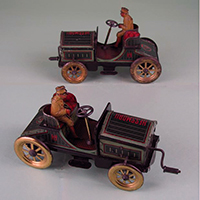 |
||||
|---|---|---|---|---|
 |
Hessmobil 1053 sedan, circa early 1930s L 7.75” (19.7 cm), W 2.75” (7 cm), H 3.63” (9.2 cm) Hessmobil 1053 sedan, marked “1053”, “JLH” logo, “D.R.P.”, “D.R.G.M.” and “Hessmobil”. Cranked flywheel propulsion with front wheel drive. |
|||
 |
Hessmobil 1054 Touring car, circa early 1930s L 9.25” (23.5 cm), W 3.25” (6.3 cm), H3.63” (9.2 cm) Hessmobil 1054 touring car, marked “1054”, “JLH” logo, “D.R.P.”, “D.R.G.M.” and “Hessmobil”. Cranked flywheel propulsion with front wheel drive. |
|||
 |
Hessmobil 1055 Limousine, circa early 1930s L 8.75” (22.2 cm), W 3.25” (6.3 cm), H 4” (10.2 cm) Hessmobil 1055 limousine marked “1055”, “JLH” loco, “D.R.P”, “D.R.G.M.” and “Hessmobil”. Cranked flywheel propulsion with front wheel drive. One rear door opens on right rear side. |
|||
 |
HESSMOBIL 1050 SERIES AUTOMOBILES 1051 car: L 7”, W 2.5”, H 3.5”, 1052 Car: L 7.75”, W 2.75”, H 3.5”, 1053 Car: L 7.75”, W 2.75”, H 3.625”, 1054 Car: L 9.25”, W 3.25”, H 3.625”, 1055 car: L 8.75”, W 3.25”, H 4”. All vehicles marked with JLH logo, model number and “Hessmobil”. Clockwise from left; 1051 Hessmobil roadster, 1053 Hessmobil sedan, 1055 Hessmobil limousine, 1054 Hessmobil touring car, 1052 Hessmobil runabout. The 1050 series was only made from the very late 1920s until 1934, when Hess ceased business. Consequently, very few were manufactured compared to earlier Hessmobils and are extremely difficult to find. All vehicles in the series used cranked flywheel propulsion actuated by a mechanism on the hood. Front wheel drive was incorporated for all vehicles. The only vehicle with opening doors is the 1055 limousine, with one door opening on the passenger side of vehicle. The 1050 Hessmobil is missing from this grouping. Both the 1050 and 1051 were roadster versions of the 1052; the 1050 having a squared back, the 1051 with a rounded back. All of the 1050 series used the improved cranking system allowing for more synchronized meshing of gears and cranking in the clockwise only direction. |
|||
 |
A pair of early Hessmobils, smaller than previously produced autos. As the competition for the toy trade increased, the demand for ways to produce more toys for less cost was always of concern. This is so evident as I watch Hess production techniques of manufacture change through the years.
|
|||

